A Comparative Report on Organizational Behavior: Capco and HSBC
VerifiedAdded on 2019/12/17
|19
|5883
|131
Report
AI Summary
This report provides a comprehensive analysis of organizational behavior, focusing on Capco and HSBC as case studies. It delves into the comparison of organizational structures and cultures, examining the relationship between them. The report explores factors influencing individual behavior, including personal traits, leadership styles, and job responsibilities. It compares the effectiveness of different leadership approaches, such as autocratic and transformational styles, and evaluates the influence of organizational theories, including scientific management and administrative theory, on management practices. Furthermore, the report examines the impact of leadership on motivation, comparing motivational theories, and analyzing the requirements for effective managers. Finally, it addresses the nature of groups and their behavior, factors affecting team development, and the impact of technology on organizational dynamics. The report concludes with insights into how these elements contribute to overall organizational performance and success within the finance sector.
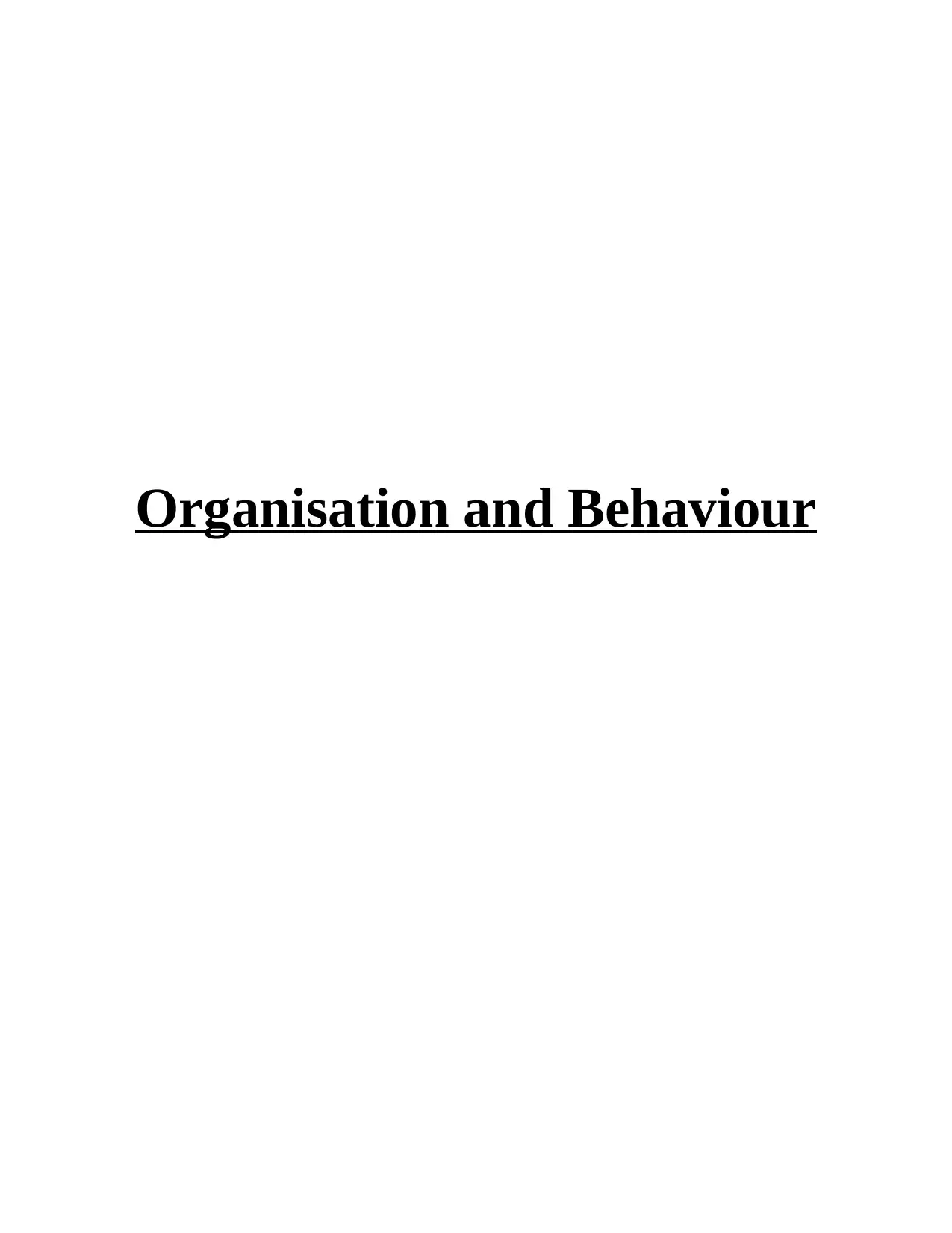
Organisation and Behaviour
Paraphrase This Document
Need a fresh take? Get an instant paraphrase of this document with our AI Paraphraser
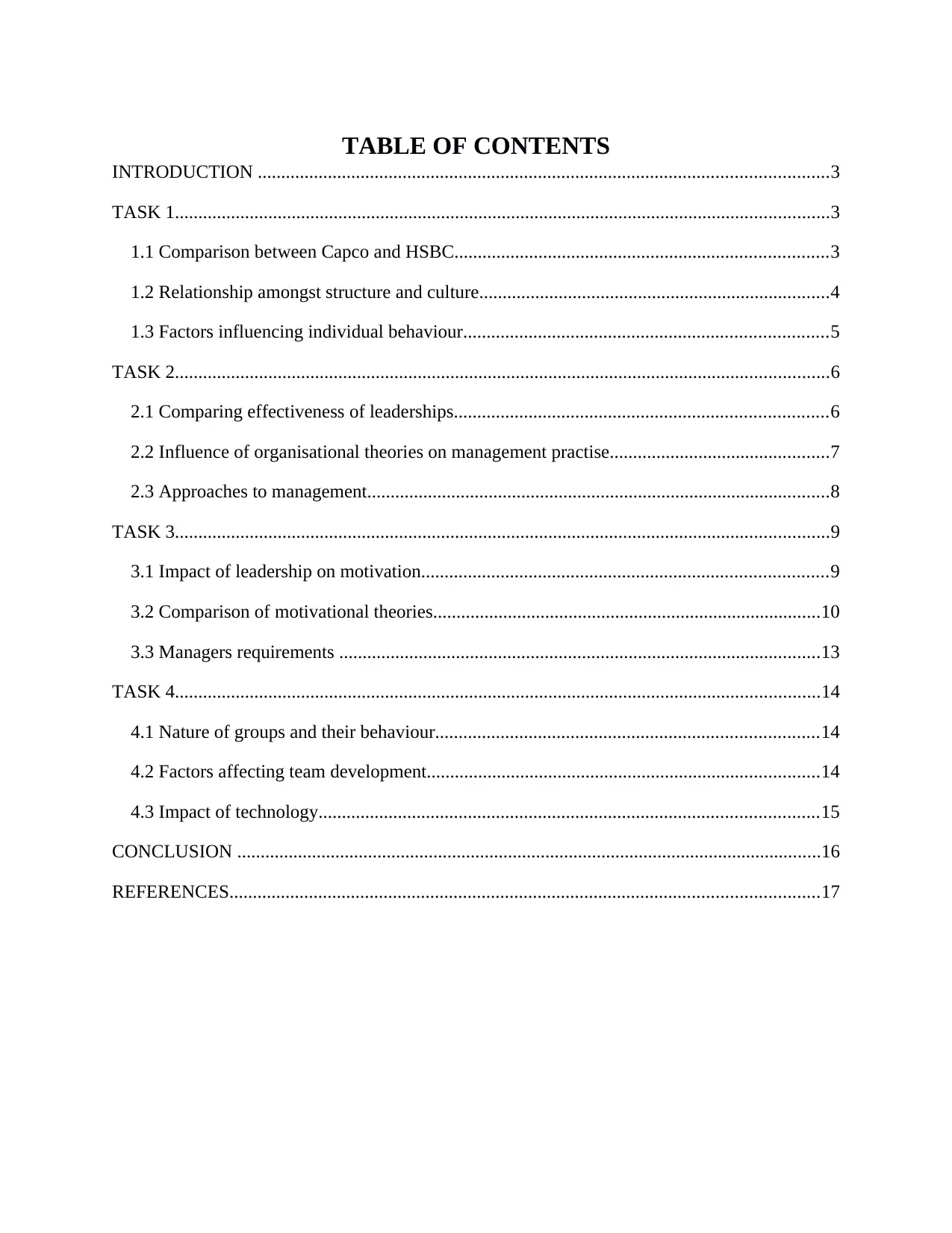
TABLE OF CONTENTS
INTRODUCTION ..........................................................................................................................3
TASK 1............................................................................................................................................3
1.1 Comparison between Capco and HSBC................................................................................3
1.2 Relationship amongst structure and culture...........................................................................4
1.3 Factors influencing individual behaviour..............................................................................5
TASK 2............................................................................................................................................6
2.1 Comparing effectiveness of leaderships................................................................................6
2.2 Influence of organisational theories on management practise...............................................7
2.3 Approaches to management...................................................................................................8
TASK 3............................................................................................................................................9
3.1 Impact of leadership on motivation.......................................................................................9
3.2 Comparison of motivational theories...................................................................................10
3.3 Managers requirements .......................................................................................................13
TASK 4..........................................................................................................................................14
4.1 Nature of groups and their behaviour..................................................................................14
4.2 Factors affecting team development....................................................................................14
4.3 Impact of technology...........................................................................................................15
CONCLUSION .............................................................................................................................16
REFERENCES..............................................................................................................................17
INTRODUCTION ..........................................................................................................................3
TASK 1............................................................................................................................................3
1.1 Comparison between Capco and HSBC................................................................................3
1.2 Relationship amongst structure and culture...........................................................................4
1.3 Factors influencing individual behaviour..............................................................................5
TASK 2............................................................................................................................................6
2.1 Comparing effectiveness of leaderships................................................................................6
2.2 Influence of organisational theories on management practise...............................................7
2.3 Approaches to management...................................................................................................8
TASK 3............................................................................................................................................9
3.1 Impact of leadership on motivation.......................................................................................9
3.2 Comparison of motivational theories...................................................................................10
3.3 Managers requirements .......................................................................................................13
TASK 4..........................................................................................................................................14
4.1 Nature of groups and their behaviour..................................................................................14
4.2 Factors affecting team development....................................................................................14
4.3 Impact of technology...........................................................................................................15
CONCLUSION .............................................................................................................................16
REFERENCES..............................................................................................................................17
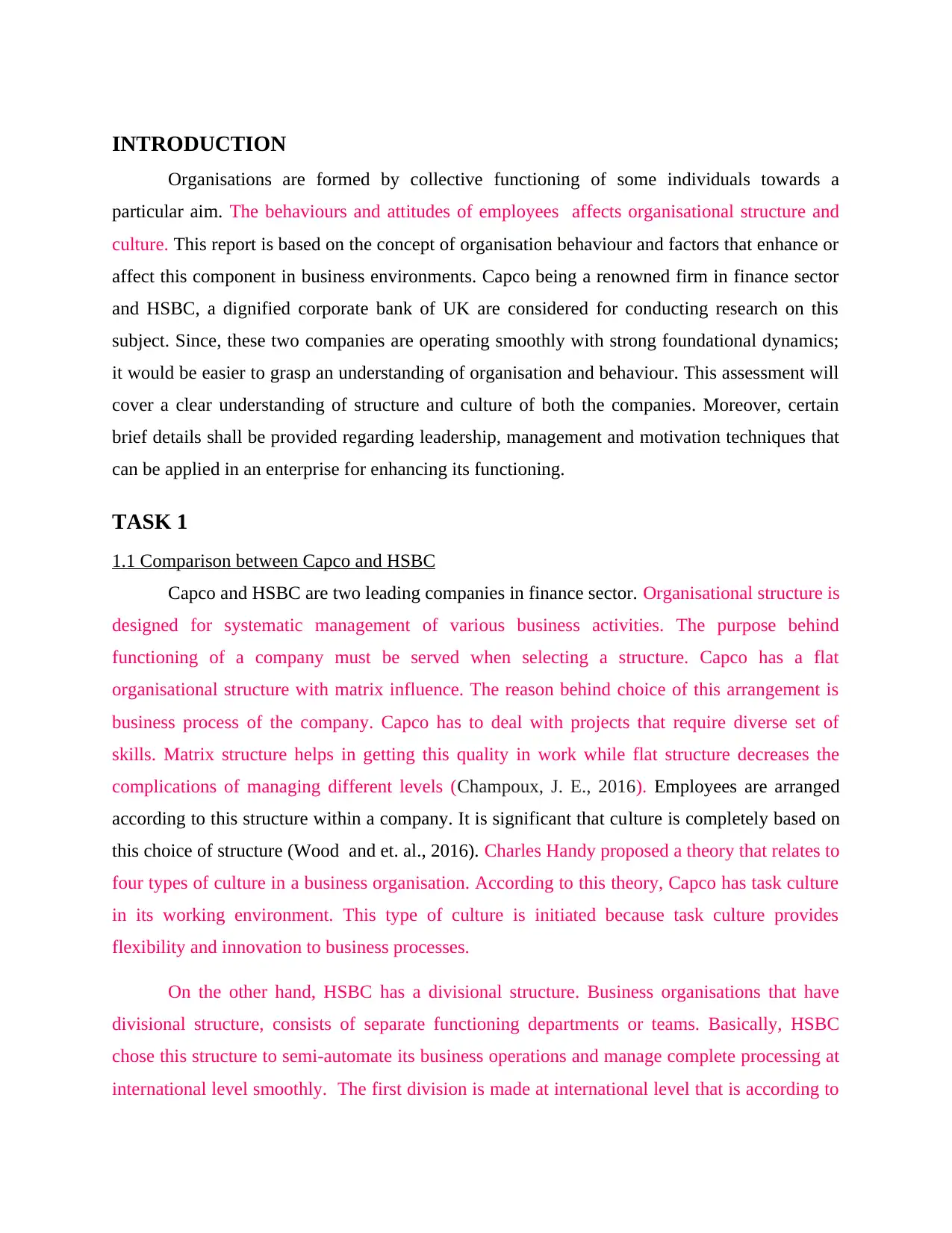
INTRODUCTION
Organisations are formed by collective functioning of some individuals towards a
particular aim. The behaviours and attitudes of employees affects organisational structure and
culture. This report is based on the concept of organisation behaviour and factors that enhance or
affect this component in business environments. Capco being a renowned firm in finance sector
and HSBC, a dignified corporate bank of UK are considered for conducting research on this
subject. Since, these two companies are operating smoothly with strong foundational dynamics;
it would be easier to grasp an understanding of organisation and behaviour. This assessment will
cover a clear understanding of structure and culture of both the companies. Moreover, certain
brief details shall be provided regarding leadership, management and motivation techniques that
can be applied in an enterprise for enhancing its functioning.
TASK 1
1.1 Comparison between Capco and HSBC
Capco and HSBC are two leading companies in finance sector. Organisational structure is
designed for systematic management of various business activities. The purpose behind
functioning of a company must be served when selecting a structure. Capco has a flat
organisational structure with matrix influence. The reason behind choice of this arrangement is
business process of the company. Capco has to deal with projects that require diverse set of
skills. Matrix structure helps in getting this quality in work while flat structure decreases the
complications of managing different levels (Champoux, J. E., 2016). Employees are arranged
according to this structure within a company. It is significant that culture is completely based on
this choice of structure (Wood and et. al., 2016). Charles Handy proposed a theory that relates to
four types of culture in a business organisation. According to this theory, Capco has task culture
in its working environment. This type of culture is initiated because task culture provides
flexibility and innovation to business processes.
On the other hand, HSBC has a divisional structure. Business organisations that have
divisional structure, consists of separate functioning departments or teams. Basically, HSBC
chose this structure to semi-automate its business operations and manage complete processing at
international level smoothly. The first division is made at international level that is according to
Organisations are formed by collective functioning of some individuals towards a
particular aim. The behaviours and attitudes of employees affects organisational structure and
culture. This report is based on the concept of organisation behaviour and factors that enhance or
affect this component in business environments. Capco being a renowned firm in finance sector
and HSBC, a dignified corporate bank of UK are considered for conducting research on this
subject. Since, these two companies are operating smoothly with strong foundational dynamics;
it would be easier to grasp an understanding of organisation and behaviour. This assessment will
cover a clear understanding of structure and culture of both the companies. Moreover, certain
brief details shall be provided regarding leadership, management and motivation techniques that
can be applied in an enterprise for enhancing its functioning.
TASK 1
1.1 Comparison between Capco and HSBC
Capco and HSBC are two leading companies in finance sector. Organisational structure is
designed for systematic management of various business activities. The purpose behind
functioning of a company must be served when selecting a structure. Capco has a flat
organisational structure with matrix influence. The reason behind choice of this arrangement is
business process of the company. Capco has to deal with projects that require diverse set of
skills. Matrix structure helps in getting this quality in work while flat structure decreases the
complications of managing different levels (Champoux, J. E., 2016). Employees are arranged
according to this structure within a company. It is significant that culture is completely based on
this choice of structure (Wood and et. al., 2016). Charles Handy proposed a theory that relates to
four types of culture in a business organisation. According to this theory, Capco has task culture
in its working environment. This type of culture is initiated because task culture provides
flexibility and innovation to business processes.
On the other hand, HSBC has a divisional structure. Business organisations that have
divisional structure, consists of separate functioning departments or teams. Basically, HSBC
chose this structure to semi-automate its business operations and manage complete processing at
international level smoothly. The first division is made at international level that is according to
⊘ This is a preview!⊘
Do you want full access?
Subscribe today to unlock all pages.

Trusted by 1+ million students worldwide
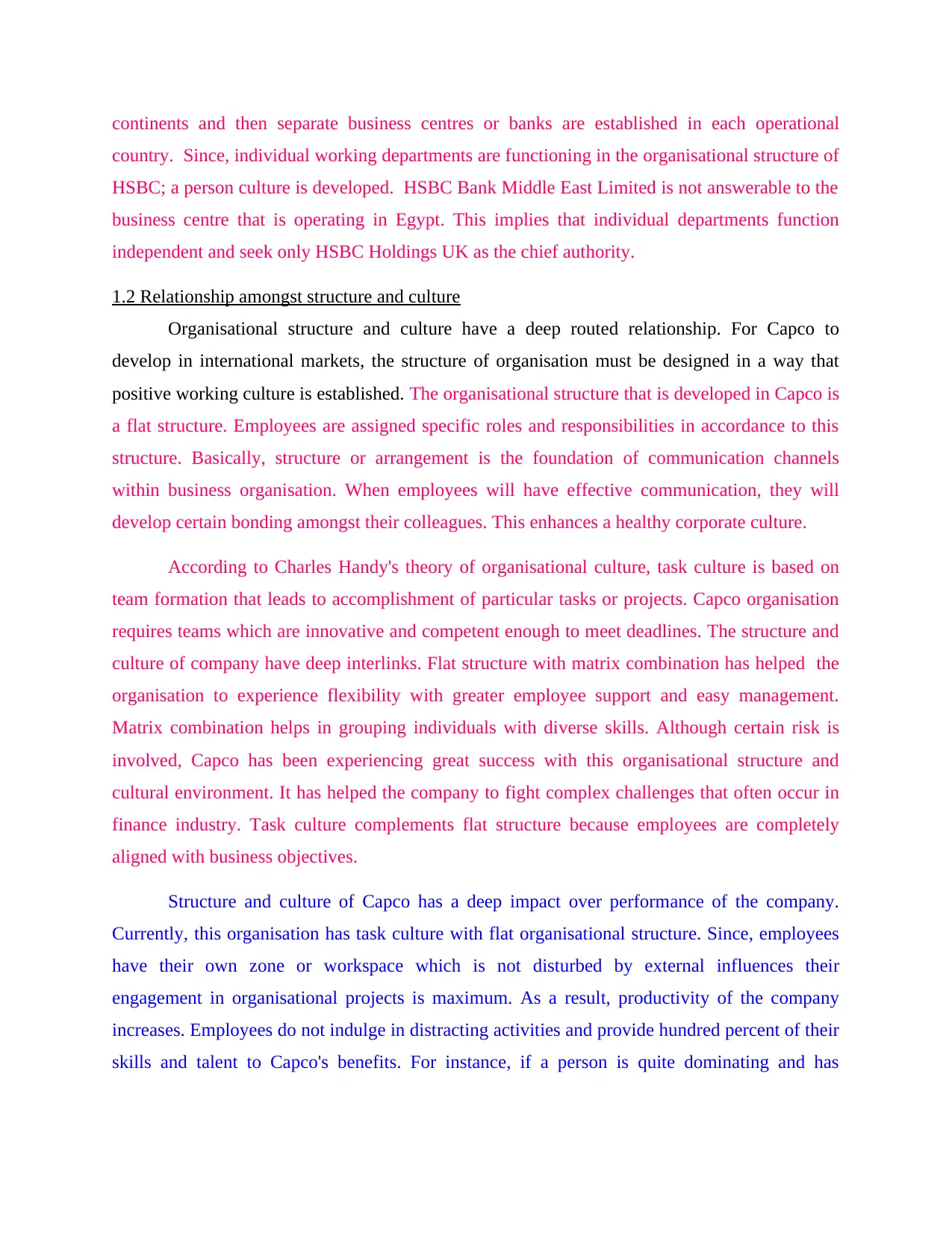
continents and then separate business centres or banks are established in each operational
country. Since, individual working departments are functioning in the organisational structure of
HSBC; a person culture is developed. HSBC Bank Middle East Limited is not answerable to the
business centre that is operating in Egypt. This implies that individual departments function
independent and seek only HSBC Holdings UK as the chief authority.
1.2 Relationship amongst structure and culture
Organisational structure and culture have a deep routed relationship. For Capco to
develop in international markets, the structure of organisation must be designed in a way that
positive working culture is established. The organisational structure that is developed in Capco is
a flat structure. Employees are assigned specific roles and responsibilities in accordance to this
structure. Basically, structure or arrangement is the foundation of communication channels
within business organisation. When employees will have effective communication, they will
develop certain bonding amongst their colleagues. This enhances a healthy corporate culture.
According to Charles Handy's theory of organisational culture, task culture is based on
team formation that leads to accomplishment of particular tasks or projects. Capco organisation
requires teams which are innovative and competent enough to meet deadlines. The structure and
culture of company have deep interlinks. Flat structure with matrix combination has helped the
organisation to experience flexibility with greater employee support and easy management.
Matrix combination helps in grouping individuals with diverse skills. Although certain risk is
involved, Capco has been experiencing great success with this organisational structure and
cultural environment. It has helped the company to fight complex challenges that often occur in
finance industry. Task culture complements flat structure because employees are completely
aligned with business objectives.
Structure and culture of Capco has a deep impact over performance of the company.
Currently, this organisation has task culture with flat organisational structure. Since, employees
have their own zone or workspace which is not disturbed by external influences their
engagement in organisational projects is maximum. As a result, productivity of the company
increases. Employees do not indulge in distracting activities and provide hundred percent of their
skills and talent to Capco's benefits. For instance, if a person is quite dominating and has
country. Since, individual working departments are functioning in the organisational structure of
HSBC; a person culture is developed. HSBC Bank Middle East Limited is not answerable to the
business centre that is operating in Egypt. This implies that individual departments function
independent and seek only HSBC Holdings UK as the chief authority.
1.2 Relationship amongst structure and culture
Organisational structure and culture have a deep routed relationship. For Capco to
develop in international markets, the structure of organisation must be designed in a way that
positive working culture is established. The organisational structure that is developed in Capco is
a flat structure. Employees are assigned specific roles and responsibilities in accordance to this
structure. Basically, structure or arrangement is the foundation of communication channels
within business organisation. When employees will have effective communication, they will
develop certain bonding amongst their colleagues. This enhances a healthy corporate culture.
According to Charles Handy's theory of organisational culture, task culture is based on
team formation that leads to accomplishment of particular tasks or projects. Capco organisation
requires teams which are innovative and competent enough to meet deadlines. The structure and
culture of company have deep interlinks. Flat structure with matrix combination has helped the
organisation to experience flexibility with greater employee support and easy management.
Matrix combination helps in grouping individuals with diverse skills. Although certain risk is
involved, Capco has been experiencing great success with this organisational structure and
cultural environment. It has helped the company to fight complex challenges that often occur in
finance industry. Task culture complements flat structure because employees are completely
aligned with business objectives.
Structure and culture of Capco has a deep impact over performance of the company.
Currently, this organisation has task culture with flat organisational structure. Since, employees
have their own zone or workspace which is not disturbed by external influences their
engagement in organisational projects is maximum. As a result, productivity of the company
increases. Employees do not indulge in distracting activities and provide hundred percent of their
skills and talent to Capco's benefits. For instance, if a person is quite dominating and has
Paraphrase This Document
Need a fresh take? Get an instant paraphrase of this document with our AI Paraphraser
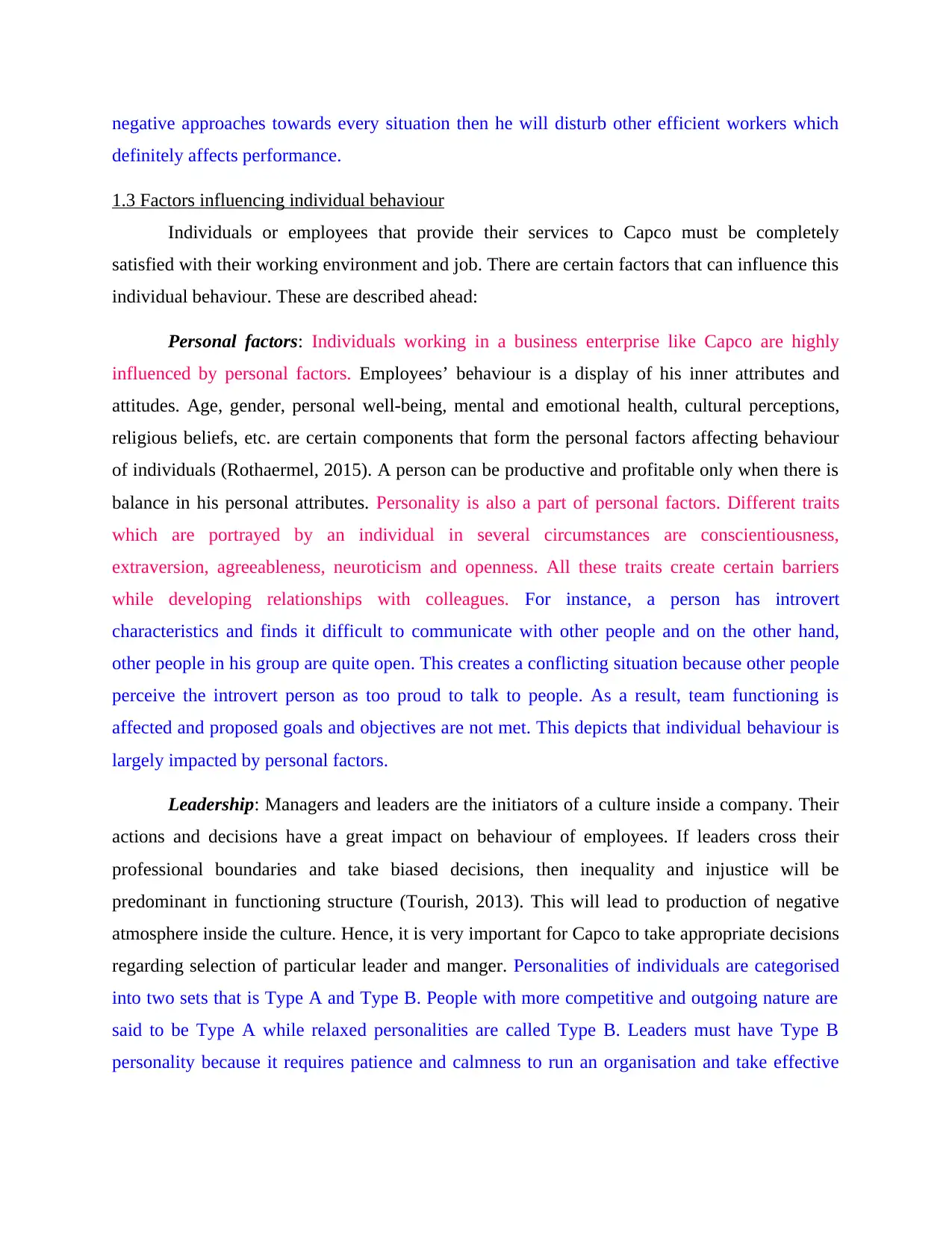
negative approaches towards every situation then he will disturb other efficient workers which
definitely affects performance.
1.3 Factors influencing individual behaviour
Individuals or employees that provide their services to Capco must be completely
satisfied with their working environment and job. There are certain factors that can influence this
individual behaviour. These are described ahead:
Personal factors: Individuals working in a business enterprise like Capco are highly
influenced by personal factors. Employees’ behaviour is a display of his inner attributes and
attitudes. Age, gender, personal well-being, mental and emotional health, cultural perceptions,
religious beliefs, etc. are certain components that form the personal factors affecting behaviour
of individuals (Rothaermel, 2015). A person can be productive and profitable only when there is
balance in his personal attributes. Personality is also a part of personal factors. Different traits
which are portrayed by an individual in several circumstances are conscientiousness,
extraversion, agreeableness, neuroticism and openness. All these traits create certain barriers
while developing relationships with colleagues. For instance, a person has introvert
characteristics and finds it difficult to communicate with other people and on the other hand,
other people in his group are quite open. This creates a conflicting situation because other people
perceive the introvert person as too proud to talk to people. As a result, team functioning is
affected and proposed goals and objectives are not met. This depicts that individual behaviour is
largely impacted by personal factors.
Leadership: Managers and leaders are the initiators of a culture inside a company. Their
actions and decisions have a great impact on behaviour of employees. If leaders cross their
professional boundaries and take biased decisions, then inequality and injustice will be
predominant in functioning structure (Tourish, 2013). This will lead to production of negative
atmosphere inside the culture. Hence, it is very important for Capco to take appropriate decisions
regarding selection of particular leader and manger. Personalities of individuals are categorised
into two sets that is Type A and Type B. People with more competitive and outgoing nature are
said to be Type A while relaxed personalities are called Type B. Leaders must have Type B
personality because it requires patience and calmness to run an organisation and take effective
definitely affects performance.
1.3 Factors influencing individual behaviour
Individuals or employees that provide their services to Capco must be completely
satisfied with their working environment and job. There are certain factors that can influence this
individual behaviour. These are described ahead:
Personal factors: Individuals working in a business enterprise like Capco are highly
influenced by personal factors. Employees’ behaviour is a display of his inner attributes and
attitudes. Age, gender, personal well-being, mental and emotional health, cultural perceptions,
religious beliefs, etc. are certain components that form the personal factors affecting behaviour
of individuals (Rothaermel, 2015). A person can be productive and profitable only when there is
balance in his personal attributes. Personality is also a part of personal factors. Different traits
which are portrayed by an individual in several circumstances are conscientiousness,
extraversion, agreeableness, neuroticism and openness. All these traits create certain barriers
while developing relationships with colleagues. For instance, a person has introvert
characteristics and finds it difficult to communicate with other people and on the other hand,
other people in his group are quite open. This creates a conflicting situation because other people
perceive the introvert person as too proud to talk to people. As a result, team functioning is
affected and proposed goals and objectives are not met. This depicts that individual behaviour is
largely impacted by personal factors.
Leadership: Managers and leaders are the initiators of a culture inside a company. Their
actions and decisions have a great impact on behaviour of employees. If leaders cross their
professional boundaries and take biased decisions, then inequality and injustice will be
predominant in functioning structure (Tourish, 2013). This will lead to production of negative
atmosphere inside the culture. Hence, it is very important for Capco to take appropriate decisions
regarding selection of particular leader and manger. Personalities of individuals are categorised
into two sets that is Type A and Type B. People with more competitive and outgoing nature are
said to be Type A while relaxed personalities are called Type B. Leaders must have Type B
personality because it requires patience and calmness to run an organisation and take effective
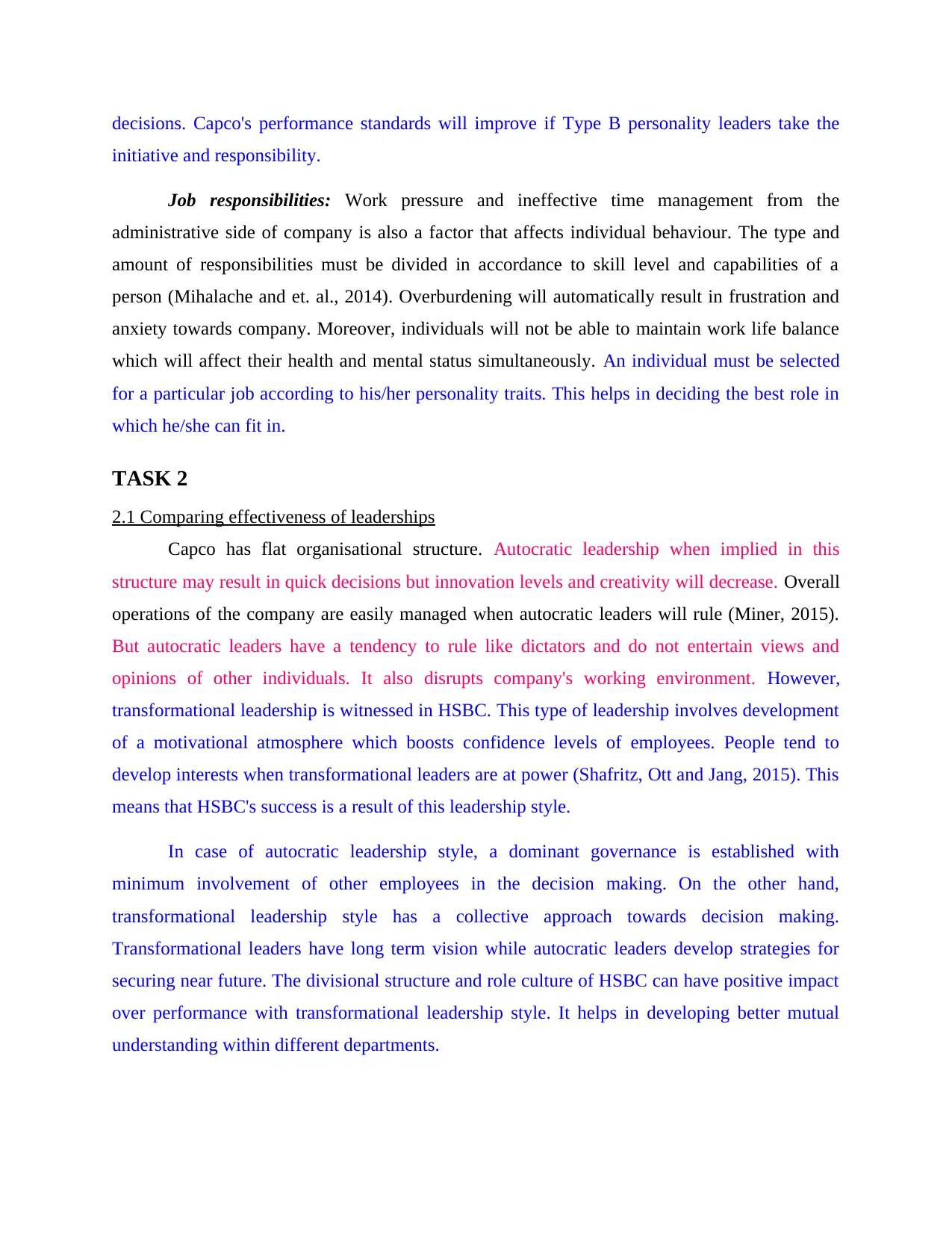
decisions. Capco's performance standards will improve if Type B personality leaders take the
initiative and responsibility.
Job responsibilities: Work pressure and ineffective time management from the
administrative side of company is also a factor that affects individual behaviour. The type and
amount of responsibilities must be divided in accordance to skill level and capabilities of a
person (Mihalache and et. al., 2014). Overburdening will automatically result in frustration and
anxiety towards company. Moreover, individuals will not be able to maintain work life balance
which will affect their health and mental status simultaneously. An individual must be selected
for a particular job according to his/her personality traits. This helps in deciding the best role in
which he/she can fit in.
TASK 2
2.1 Comparing effectiveness of leaderships
Capco has flat organisational structure. Autocratic leadership when implied in this
structure may result in quick decisions but innovation levels and creativity will decrease. Overall
operations of the company are easily managed when autocratic leaders will rule (Miner, 2015).
But autocratic leaders have a tendency to rule like dictators and do not entertain views and
opinions of other individuals. It also disrupts company's working environment. However,
transformational leadership is witnessed in HSBC. This type of leadership involves development
of a motivational atmosphere which boosts confidence levels of employees. People tend to
develop interests when transformational leaders are at power (Shafritz, Ott and Jang, 2015). This
means that HSBC's success is a result of this leadership style.
In case of autocratic leadership style, a dominant governance is established with
minimum involvement of other employees in the decision making. On the other hand,
transformational leadership style has a collective approach towards decision making.
Transformational leaders have long term vision while autocratic leaders develop strategies for
securing near future. The divisional structure and role culture of HSBC can have positive impact
over performance with transformational leadership style. It helps in developing better mutual
understanding within different departments.
initiative and responsibility.
Job responsibilities: Work pressure and ineffective time management from the
administrative side of company is also a factor that affects individual behaviour. The type and
amount of responsibilities must be divided in accordance to skill level and capabilities of a
person (Mihalache and et. al., 2014). Overburdening will automatically result in frustration and
anxiety towards company. Moreover, individuals will not be able to maintain work life balance
which will affect their health and mental status simultaneously. An individual must be selected
for a particular job according to his/her personality traits. This helps in deciding the best role in
which he/she can fit in.
TASK 2
2.1 Comparing effectiveness of leaderships
Capco has flat organisational structure. Autocratic leadership when implied in this
structure may result in quick decisions but innovation levels and creativity will decrease. Overall
operations of the company are easily managed when autocratic leaders will rule (Miner, 2015).
But autocratic leaders have a tendency to rule like dictators and do not entertain views and
opinions of other individuals. It also disrupts company's working environment. However,
transformational leadership is witnessed in HSBC. This type of leadership involves development
of a motivational atmosphere which boosts confidence levels of employees. People tend to
develop interests when transformational leaders are at power (Shafritz, Ott and Jang, 2015). This
means that HSBC's success is a result of this leadership style.
In case of autocratic leadership style, a dominant governance is established with
minimum involvement of other employees in the decision making. On the other hand,
transformational leadership style has a collective approach towards decision making.
Transformational leaders have long term vision while autocratic leaders develop strategies for
securing near future. The divisional structure and role culture of HSBC can have positive impact
over performance with transformational leadership style. It helps in developing better mutual
understanding within different departments.
⊘ This is a preview!⊘
Do you want full access?
Subscribe today to unlock all pages.

Trusted by 1+ million students worldwide
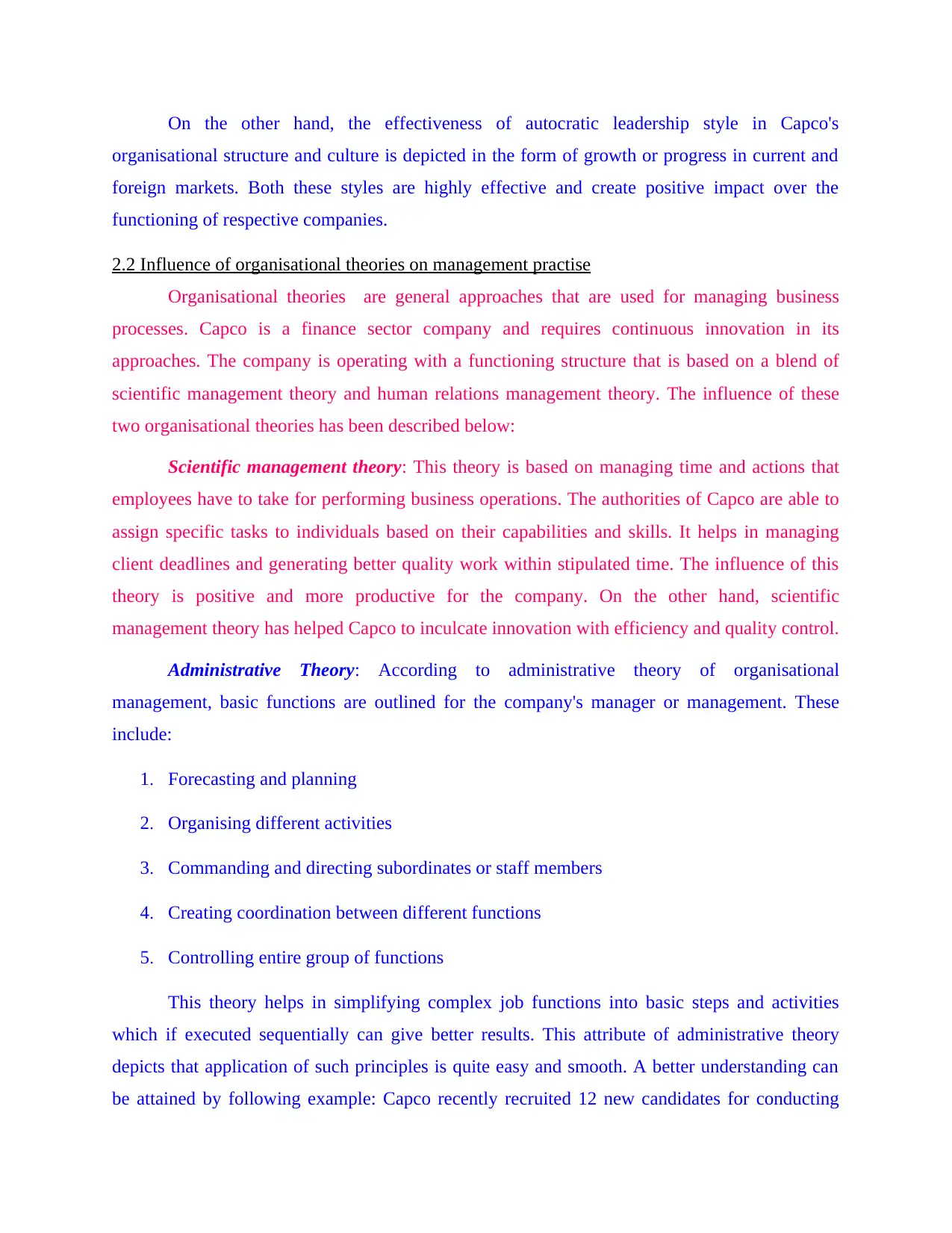
On the other hand, the effectiveness of autocratic leadership style in Capco's
organisational structure and culture is depicted in the form of growth or progress in current and
foreign markets. Both these styles are highly effective and create positive impact over the
functioning of respective companies.
2.2 Influence of organisational theories on management practise
Organisational theories are general approaches that are used for managing business
processes. Capco is a finance sector company and requires continuous innovation in its
approaches. The company is operating with a functioning structure that is based on a blend of
scientific management theory and human relations management theory. The influence of these
two organisational theories has been described below:
Scientific management theory: This theory is based on managing time and actions that
employees have to take for performing business operations. The authorities of Capco are able to
assign specific tasks to individuals based on their capabilities and skills. It helps in managing
client deadlines and generating better quality work within stipulated time. The influence of this
theory is positive and more productive for the company. On the other hand, scientific
management theory has helped Capco to inculcate innovation with efficiency and quality control.
Administrative Theory: According to administrative theory of organisational
management, basic functions are outlined for the company's manager or management. These
include:
1. Forecasting and planning
2. Organising different activities
3. Commanding and directing subordinates or staff members
4. Creating coordination between different functions
5. Controlling entire group of functions
This theory helps in simplifying complex job functions into basic steps and activities
which if executed sequentially can give better results. This attribute of administrative theory
depicts that application of such principles is quite easy and smooth. A better understanding can
be attained by following example: Capco recently recruited 12 new candidates for conducting
organisational structure and culture is depicted in the form of growth or progress in current and
foreign markets. Both these styles are highly effective and create positive impact over the
functioning of respective companies.
2.2 Influence of organisational theories on management practise
Organisational theories are general approaches that are used for managing business
processes. Capco is a finance sector company and requires continuous innovation in its
approaches. The company is operating with a functioning structure that is based on a blend of
scientific management theory and human relations management theory. The influence of these
two organisational theories has been described below:
Scientific management theory: This theory is based on managing time and actions that
employees have to take for performing business operations. The authorities of Capco are able to
assign specific tasks to individuals based on their capabilities and skills. It helps in managing
client deadlines and generating better quality work within stipulated time. The influence of this
theory is positive and more productive for the company. On the other hand, scientific
management theory has helped Capco to inculcate innovation with efficiency and quality control.
Administrative Theory: According to administrative theory of organisational
management, basic functions are outlined for the company's manager or management. These
include:
1. Forecasting and planning
2. Organising different activities
3. Commanding and directing subordinates or staff members
4. Creating coordination between different functions
5. Controlling entire group of functions
This theory helps in simplifying complex job functions into basic steps and activities
which if executed sequentially can give better results. This attribute of administrative theory
depicts that application of such principles is quite easy and smooth. A better understanding can
be attained by following example: Capco recently recruited 12 new candidates for conducting
Paraphrase This Document
Need a fresh take? Get an instant paraphrase of this document with our AI Paraphraser
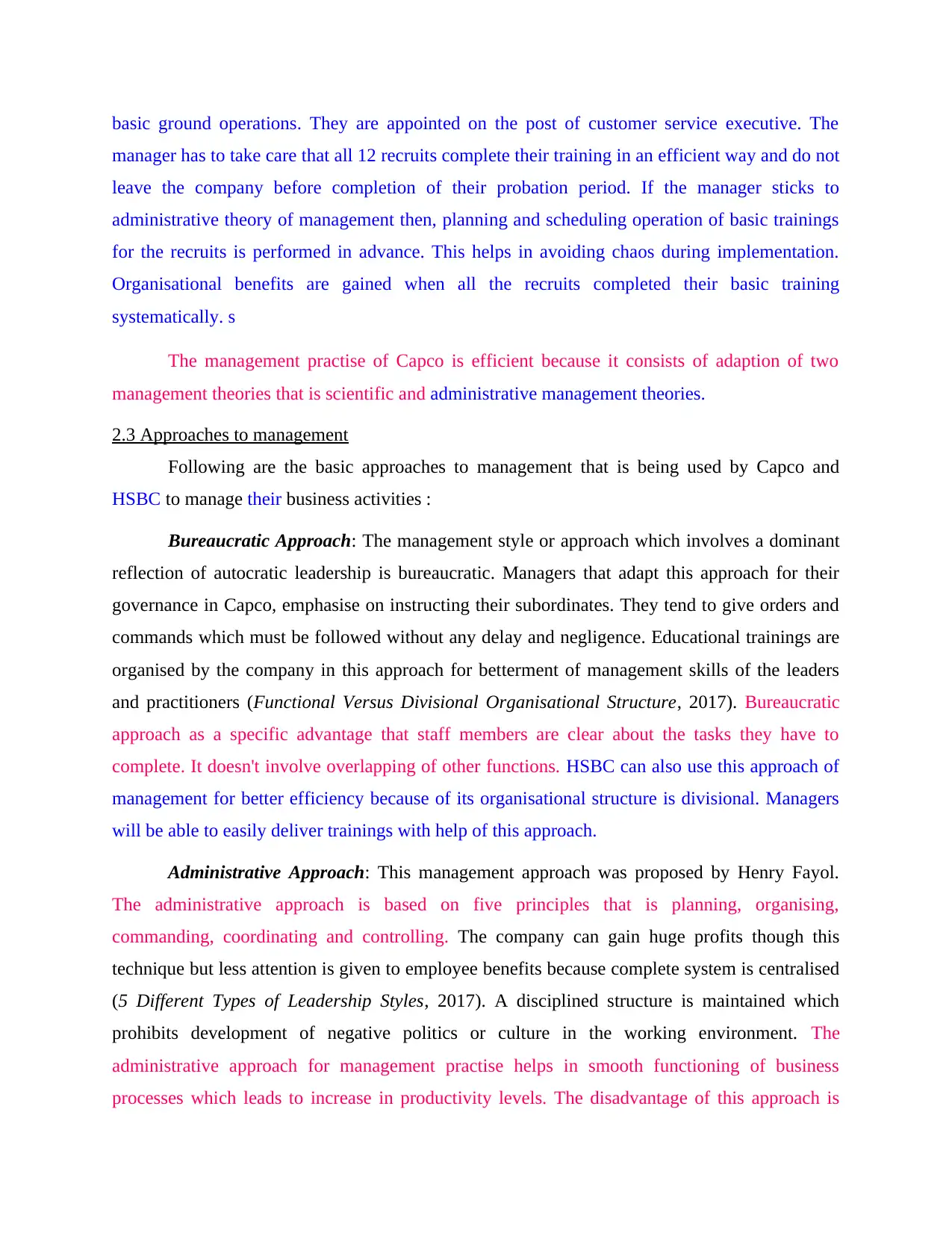
basic ground operations. They are appointed on the post of customer service executive. The
manager has to take care that all 12 recruits complete their training in an efficient way and do not
leave the company before completion of their probation period. If the manager sticks to
administrative theory of management then, planning and scheduling operation of basic trainings
for the recruits is performed in advance. This helps in avoiding chaos during implementation.
Organisational benefits are gained when all the recruits completed their basic training
systematically. s
The management practise of Capco is efficient because it consists of adaption of two
management theories that is scientific and administrative management theories.
2.3 Approaches to management
Following are the basic approaches to management that is being used by Capco and
HSBC to manage their business activities :
Bureaucratic Approach: The management style or approach which involves a dominant
reflection of autocratic leadership is bureaucratic. Managers that adapt this approach for their
governance in Capco, emphasise on instructing their subordinates. They tend to give orders and
commands which must be followed without any delay and negligence. Educational trainings are
organised by the company in this approach for betterment of management skills of the leaders
and practitioners (Functional Versus Divisional Organisational Structure, 2017). Bureaucratic
approach as a specific advantage that staff members are clear about the tasks they have to
complete. It doesn't involve overlapping of other functions. HSBC can also use this approach of
management for better efficiency because of its organisational structure is divisional. Managers
will be able to easily deliver trainings with help of this approach.
Administrative Approach: This management approach was proposed by Henry Fayol.
The administrative approach is based on five principles that is planning, organising,
commanding, coordinating and controlling. The company can gain huge profits though this
technique but less attention is given to employee benefits because complete system is centralised
(5 Different Types of Leadership Styles, 2017). A disciplined structure is maintained which
prohibits development of negative politics or culture in the working environment. The
administrative approach for management practise helps in smooth functioning of business
processes which leads to increase in productivity levels. The disadvantage of this approach is
manager has to take care that all 12 recruits complete their training in an efficient way and do not
leave the company before completion of their probation period. If the manager sticks to
administrative theory of management then, planning and scheduling operation of basic trainings
for the recruits is performed in advance. This helps in avoiding chaos during implementation.
Organisational benefits are gained when all the recruits completed their basic training
systematically. s
The management practise of Capco is efficient because it consists of adaption of two
management theories that is scientific and administrative management theories.
2.3 Approaches to management
Following are the basic approaches to management that is being used by Capco and
HSBC to manage their business activities :
Bureaucratic Approach: The management style or approach which involves a dominant
reflection of autocratic leadership is bureaucratic. Managers that adapt this approach for their
governance in Capco, emphasise on instructing their subordinates. They tend to give orders and
commands which must be followed without any delay and negligence. Educational trainings are
organised by the company in this approach for betterment of management skills of the leaders
and practitioners (Functional Versus Divisional Organisational Structure, 2017). Bureaucratic
approach as a specific advantage that staff members are clear about the tasks they have to
complete. It doesn't involve overlapping of other functions. HSBC can also use this approach of
management for better efficiency because of its organisational structure is divisional. Managers
will be able to easily deliver trainings with help of this approach.
Administrative Approach: This management approach was proposed by Henry Fayol.
The administrative approach is based on five principles that is planning, organising,
commanding, coordinating and controlling. The company can gain huge profits though this
technique but less attention is given to employee benefits because complete system is centralised
(5 Different Types of Leadership Styles, 2017). A disciplined structure is maintained which
prohibits development of negative politics or culture in the working environment. The
administrative approach for management practise helps in smooth functioning of business
processes which leads to increase in productivity levels. The disadvantage of this approach is
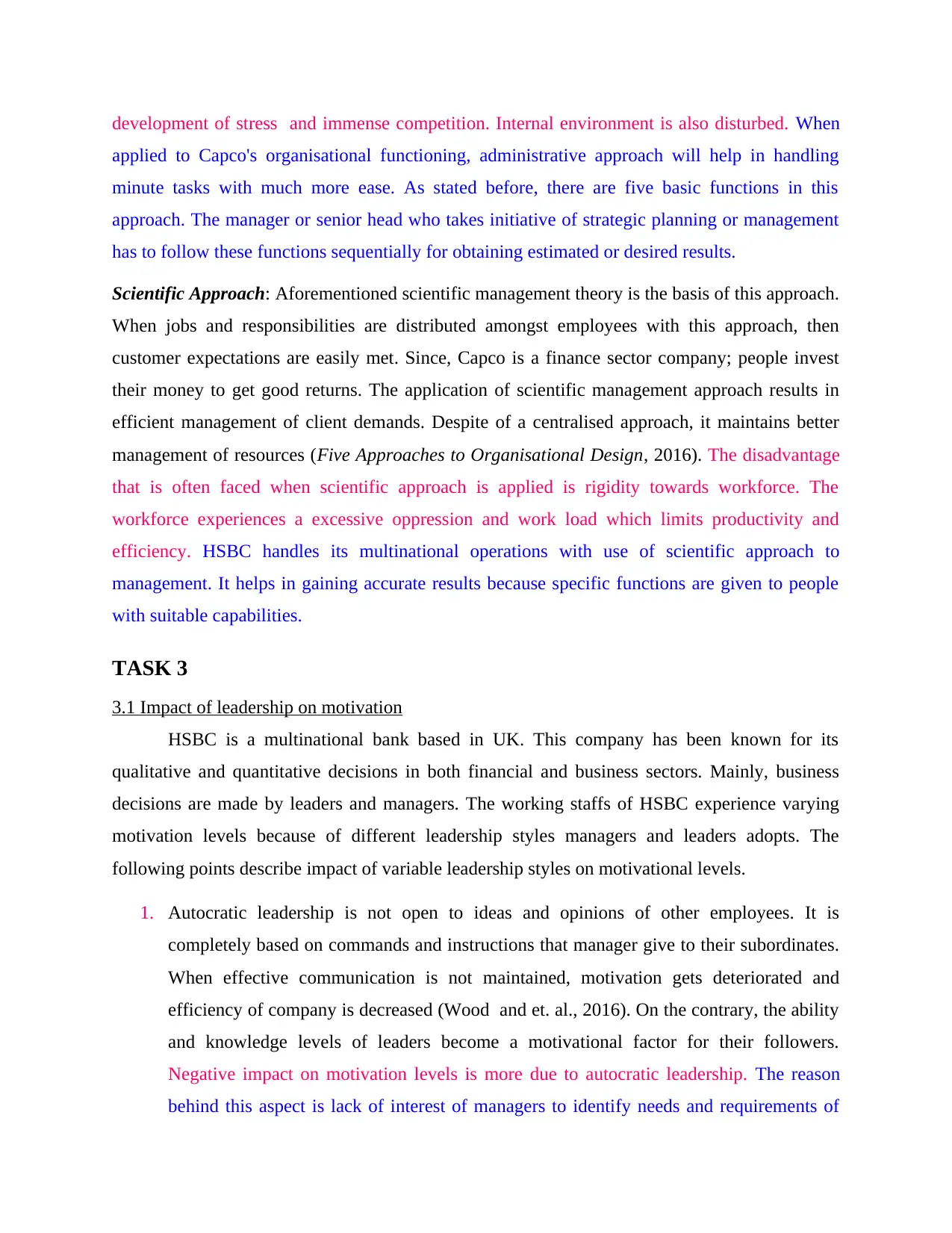
development of stress and immense competition. Internal environment is also disturbed. When
applied to Capco's organisational functioning, administrative approach will help in handling
minute tasks with much more ease. As stated before, there are five basic functions in this
approach. The manager or senior head who takes initiative of strategic planning or management
has to follow these functions sequentially for obtaining estimated or desired results.
Scientific Approach: Aforementioned scientific management theory is the basis of this approach.
When jobs and responsibilities are distributed amongst employees with this approach, then
customer expectations are easily met. Since, Capco is a finance sector company; people invest
their money to get good returns. The application of scientific management approach results in
efficient management of client demands. Despite of a centralised approach, it maintains better
management of resources (Five Approaches to Organisational Design, 2016). The disadvantage
that is often faced when scientific approach is applied is rigidity towards workforce. The
workforce experiences a excessive oppression and work load which limits productivity and
efficiency. HSBC handles its multinational operations with use of scientific approach to
management. It helps in gaining accurate results because specific functions are given to people
with suitable capabilities.
TASK 3
3.1 Impact of leadership on motivation
HSBC is a multinational bank based in UK. This company has been known for its
qualitative and quantitative decisions in both financial and business sectors. Mainly, business
decisions are made by leaders and managers. The working staffs of HSBC experience varying
motivation levels because of different leadership styles managers and leaders adopts. The
following points describe impact of variable leadership styles on motivational levels.
1. Autocratic leadership is not open to ideas and opinions of other employees. It is
completely based on commands and instructions that manager give to their subordinates.
When effective communication is not maintained, motivation gets deteriorated and
efficiency of company is decreased (Wood and et. al., 2016). On the contrary, the ability
and knowledge levels of leaders become a motivational factor for their followers.
Negative impact on motivation levels is more due to autocratic leadership. The reason
behind this aspect is lack of interest of managers to identify needs and requirements of
applied to Capco's organisational functioning, administrative approach will help in handling
minute tasks with much more ease. As stated before, there are five basic functions in this
approach. The manager or senior head who takes initiative of strategic planning or management
has to follow these functions sequentially for obtaining estimated or desired results.
Scientific Approach: Aforementioned scientific management theory is the basis of this approach.
When jobs and responsibilities are distributed amongst employees with this approach, then
customer expectations are easily met. Since, Capco is a finance sector company; people invest
their money to get good returns. The application of scientific management approach results in
efficient management of client demands. Despite of a centralised approach, it maintains better
management of resources (Five Approaches to Organisational Design, 2016). The disadvantage
that is often faced when scientific approach is applied is rigidity towards workforce. The
workforce experiences a excessive oppression and work load which limits productivity and
efficiency. HSBC handles its multinational operations with use of scientific approach to
management. It helps in gaining accurate results because specific functions are given to people
with suitable capabilities.
TASK 3
3.1 Impact of leadership on motivation
HSBC is a multinational bank based in UK. This company has been known for its
qualitative and quantitative decisions in both financial and business sectors. Mainly, business
decisions are made by leaders and managers. The working staffs of HSBC experience varying
motivation levels because of different leadership styles managers and leaders adopts. The
following points describe impact of variable leadership styles on motivational levels.
1. Autocratic leadership is not open to ideas and opinions of other employees. It is
completely based on commands and instructions that manager give to their subordinates.
When effective communication is not maintained, motivation gets deteriorated and
efficiency of company is decreased (Wood and et. al., 2016). On the contrary, the ability
and knowledge levels of leaders become a motivational factor for their followers.
Negative impact on motivation levels is more due to autocratic leadership. The reason
behind this aspect is lack of interest of managers to identify needs and requirements of
⊘ This is a preview!⊘
Do you want full access?
Subscribe today to unlock all pages.

Trusted by 1+ million students worldwide
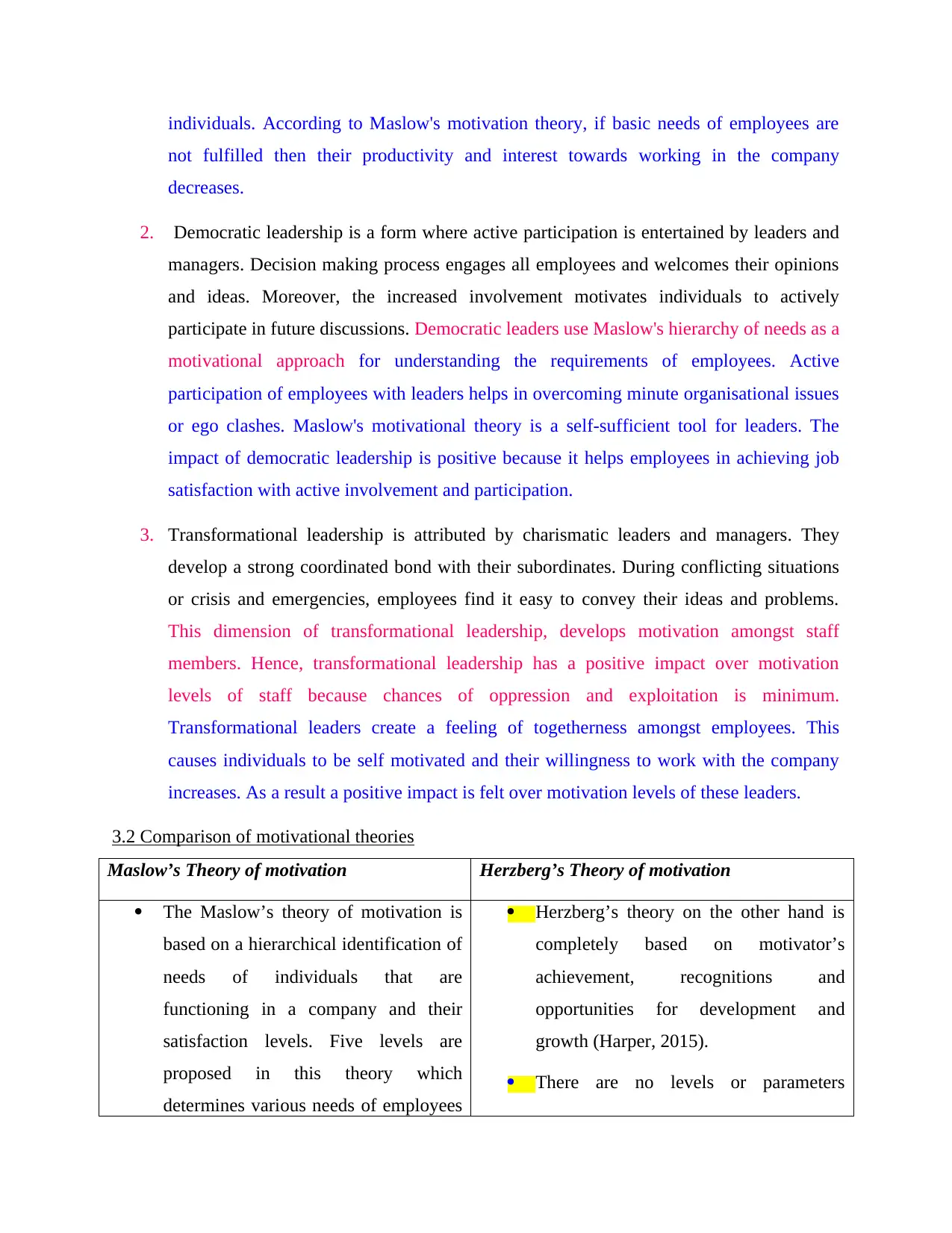
individuals. According to Maslow's motivation theory, if basic needs of employees are
not fulfilled then their productivity and interest towards working in the company
decreases.
2. Democratic leadership is a form where active participation is entertained by leaders and
managers. Decision making process engages all employees and welcomes their opinions
and ideas. Moreover, the increased involvement motivates individuals to actively
participate in future discussions. Democratic leaders use Maslow's hierarchy of needs as a
motivational approach for understanding the requirements of employees. Active
participation of employees with leaders helps in overcoming minute organisational issues
or ego clashes. Maslow's motivational theory is a self-sufficient tool for leaders. The
impact of democratic leadership is positive because it helps employees in achieving job
satisfaction with active involvement and participation.
3. Transformational leadership is attributed by charismatic leaders and managers. They
develop a strong coordinated bond with their subordinates. During conflicting situations
or crisis and emergencies, employees find it easy to convey their ideas and problems.
This dimension of transformational leadership, develops motivation amongst staff
members. Hence, transformational leadership has a positive impact over motivation
levels of staff because chances of oppression and exploitation is minimum.
Transformational leaders create a feeling of togetherness amongst employees. This
causes individuals to be self motivated and their willingness to work with the company
increases. As a result a positive impact is felt over motivation levels of these leaders.
3.2 Comparison of motivational theories
Maslow’s Theory of motivation Herzberg’s Theory of motivation
The Maslow’s theory of motivation is
based on a hierarchical identification of
needs of individuals that are
functioning in a company and their
satisfaction levels. Five levels are
proposed in this theory which
determines various needs of employees
Herzberg’s theory on the other hand is
completely based on motivator’s
achievement, recognitions and
opportunities for development and
growth (Harper, 2015).
There are no levels or parameters
not fulfilled then their productivity and interest towards working in the company
decreases.
2. Democratic leadership is a form where active participation is entertained by leaders and
managers. Decision making process engages all employees and welcomes their opinions
and ideas. Moreover, the increased involvement motivates individuals to actively
participate in future discussions. Democratic leaders use Maslow's hierarchy of needs as a
motivational approach for understanding the requirements of employees. Active
participation of employees with leaders helps in overcoming minute organisational issues
or ego clashes. Maslow's motivational theory is a self-sufficient tool for leaders. The
impact of democratic leadership is positive because it helps employees in achieving job
satisfaction with active involvement and participation.
3. Transformational leadership is attributed by charismatic leaders and managers. They
develop a strong coordinated bond with their subordinates. During conflicting situations
or crisis and emergencies, employees find it easy to convey their ideas and problems.
This dimension of transformational leadership, develops motivation amongst staff
members. Hence, transformational leadership has a positive impact over motivation
levels of staff because chances of oppression and exploitation is minimum.
Transformational leaders create a feeling of togetherness amongst employees. This
causes individuals to be self motivated and their willingness to work with the company
increases. As a result a positive impact is felt over motivation levels of these leaders.
3.2 Comparison of motivational theories
Maslow’s Theory of motivation Herzberg’s Theory of motivation
The Maslow’s theory of motivation is
based on a hierarchical identification of
needs of individuals that are
functioning in a company and their
satisfaction levels. Five levels are
proposed in this theory which
determines various needs of employees
Herzberg’s theory on the other hand is
completely based on motivator’s
achievement, recognitions and
opportunities for development and
growth (Harper, 2015).
There are no levels or parameters
Paraphrase This Document
Need a fresh take? Get an instant paraphrase of this document with our AI Paraphraser
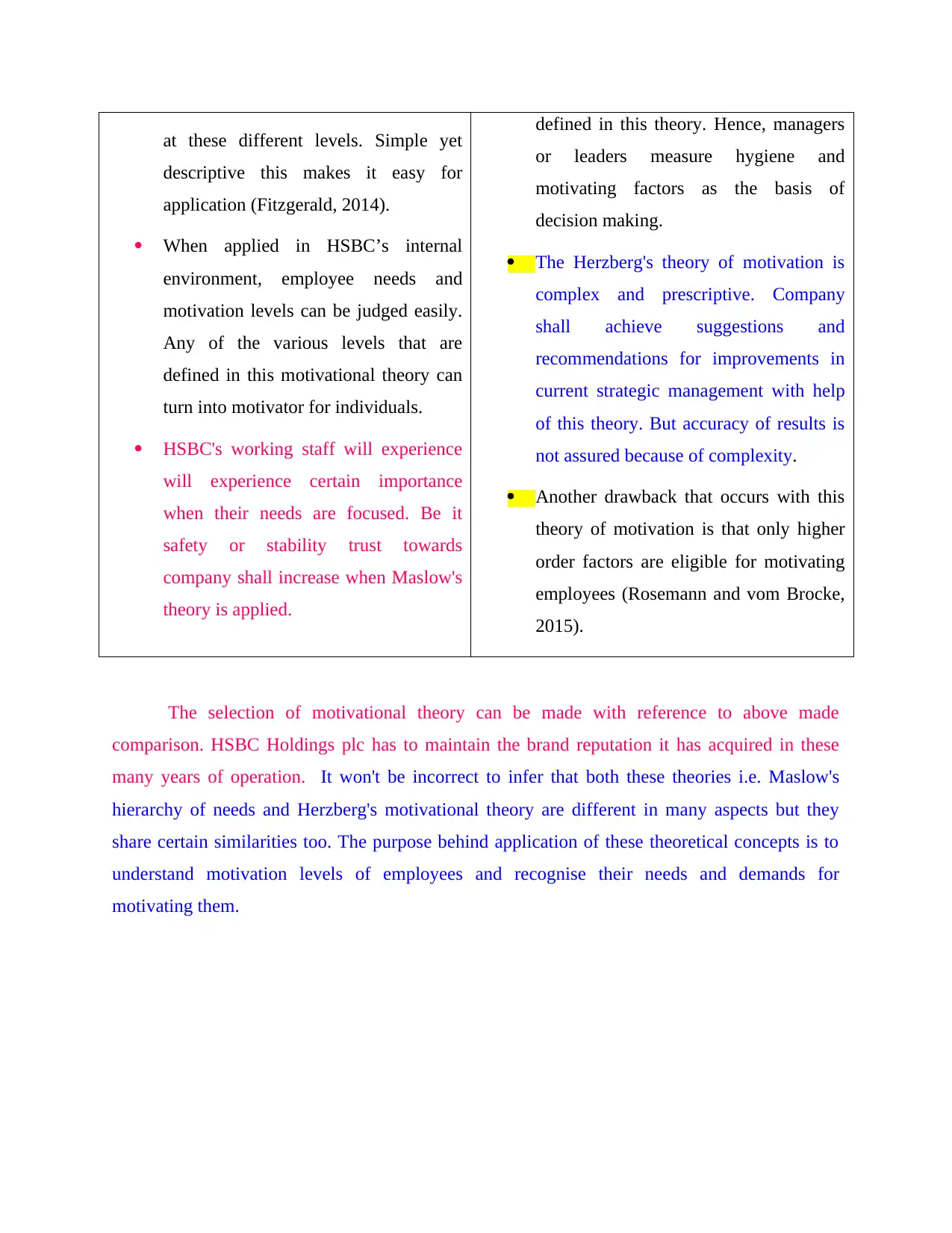
at these different levels. Simple yet
descriptive this makes it easy for
application (Fitzgerald, 2014).
When applied in HSBC’s internal
environment, employee needs and
motivation levels can be judged easily.
Any of the various levels that are
defined in this motivational theory can
turn into motivator for individuals.
HSBC's working staff will experience
will experience certain importance
when their needs are focused. Be it
safety or stability trust towards
company shall increase when Maslow's
theory is applied.
defined in this theory. Hence, managers
or leaders measure hygiene and
motivating factors as the basis of
decision making.
The Herzberg's theory of motivation is
complex and prescriptive. Company
shall achieve suggestions and
recommendations for improvements in
current strategic management with help
of this theory. But accuracy of results is
not assured because of complexity.
Another drawback that occurs with this
theory of motivation is that only higher
order factors are eligible for motivating
employees (Rosemann and vom Brocke,
2015).
The selection of motivational theory can be made with reference to above made
comparison. HSBC Holdings plc has to maintain the brand reputation it has acquired in these
many years of operation. It won't be incorrect to infer that both these theories i.e. Maslow's
hierarchy of needs and Herzberg's motivational theory are different in many aspects but they
share certain similarities too. The purpose behind application of these theoretical concepts is to
understand motivation levels of employees and recognise their needs and demands for
motivating them.
descriptive this makes it easy for
application (Fitzgerald, 2014).
When applied in HSBC’s internal
environment, employee needs and
motivation levels can be judged easily.
Any of the various levels that are
defined in this motivational theory can
turn into motivator for individuals.
HSBC's working staff will experience
will experience certain importance
when their needs are focused. Be it
safety or stability trust towards
company shall increase when Maslow's
theory is applied.
defined in this theory. Hence, managers
or leaders measure hygiene and
motivating factors as the basis of
decision making.
The Herzberg's theory of motivation is
complex and prescriptive. Company
shall achieve suggestions and
recommendations for improvements in
current strategic management with help
of this theory. But accuracy of results is
not assured because of complexity.
Another drawback that occurs with this
theory of motivation is that only higher
order factors are eligible for motivating
employees (Rosemann and vom Brocke,
2015).
The selection of motivational theory can be made with reference to above made
comparison. HSBC Holdings plc has to maintain the brand reputation it has acquired in these
many years of operation. It won't be incorrect to infer that both these theories i.e. Maslow's
hierarchy of needs and Herzberg's motivational theory are different in many aspects but they
share certain similarities too. The purpose behind application of these theoretical concepts is to
understand motivation levels of employees and recognise their needs and demands for
motivating them.

HSBC can use both these theories in different aspects. Maslow's theory of motivation
when applied to this company helps in categorising employees according to their need. For
instance, the ground level employees shall be placed at the level of basic needs. On the other
hand, leaders and senior company heads have a requirement of gaining prestige and recognition.
This means they are placed at the level of psychological needs.
when applied to this company helps in categorising employees according to their need. For
instance, the ground level employees shall be placed at the level of basic needs. On the other
hand, leaders and senior company heads have a requirement of gaining prestige and recognition.
This means they are placed at the level of psychological needs.
⊘ This is a preview!⊘
Do you want full access?
Subscribe today to unlock all pages.

Trusted by 1+ million students worldwide
1 out of 19
Related Documents
Your All-in-One AI-Powered Toolkit for Academic Success.
+13062052269
info@desklib.com
Available 24*7 on WhatsApp / Email
![[object Object]](/_next/static/media/star-bottom.7253800d.svg)
Unlock your academic potential
Copyright © 2020–2025 A2Z Services. All Rights Reserved. Developed and managed by ZUCOL.





